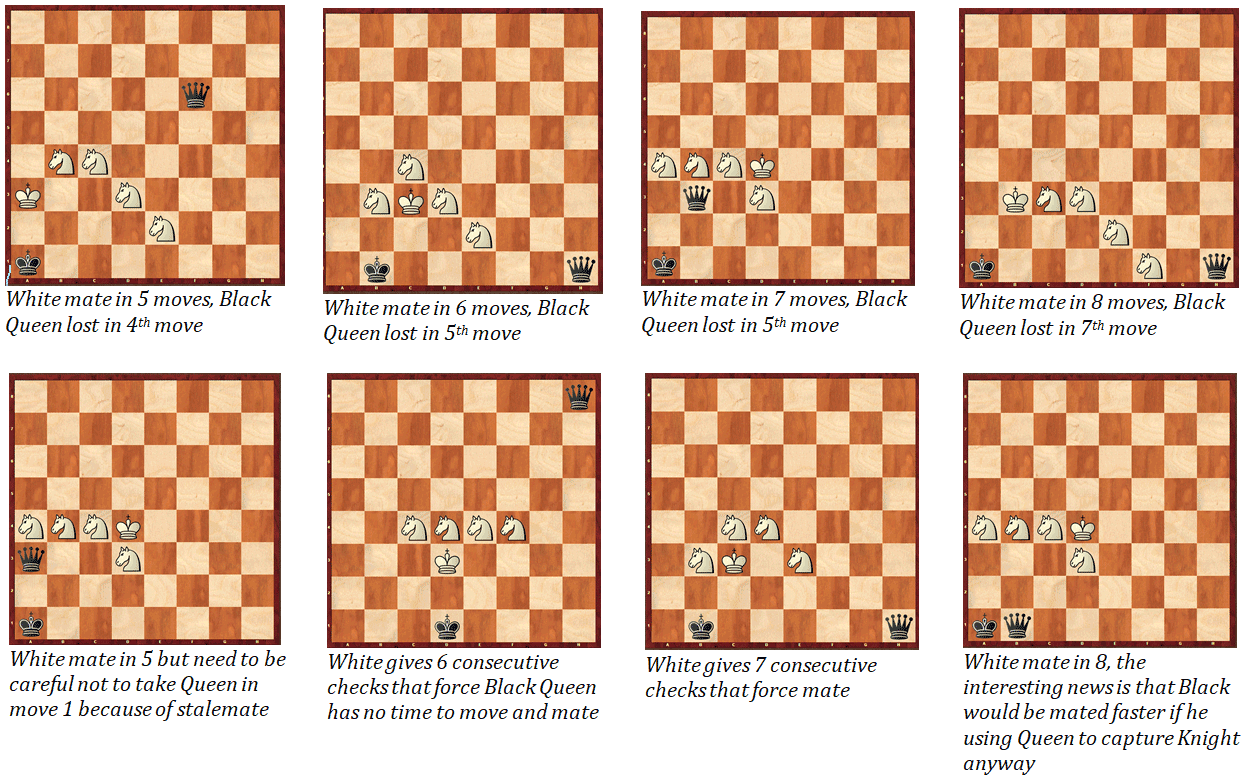


Quoc Khanh sent us the following positions he found, with the help of Houdini and two hours' work. They are checkmates in 5, 6, 7 and 8, with the black queen being lost in the very last move. The interesting part is that in each case Black would be mated faster if uses the queen to capture a knight. Here are the eight positions (click to enlarge):

 Quốc Khánh Nguyễn is a major in mathematics at Hanoi University of Science. He is currently based in Hanoi and working for a private technology company whose main field is providing enterprise software (including SAP solution) and making edge modelling for mostly Internet based company in the region. Khánh is not a professional chess player, he just loves the game and spends times studying it. "In recent years I did some commentary for chess tournaments, mostly on Facebook, with my friends," he writes. "Besides that we also work together to organize chess tournament for kids in the town."
Quốc Khánh Nguyễn is a major in mathematics at Hanoi University of Science. He is currently based in Hanoi and working for a private technology company whose main field is providing enterprise software (including SAP solution) and making edge modelling for mostly Internet based company in the region. Khánh is not a professional chess player, he just loves the game and spends times studying it. "In recent years I did some commentary for chess tournaments, mostly on Facebook, with my friends," he writes. "Besides that we also work together to organize chess tournament for kids in the town."
The positions composed by Khanh/Houdini are not chess problems in the classical sense, but do contain interesting manoeuvres and pictures. Take a look at the mate at the top of this page, for instance. You can experiment with all the positions in our replayer:

 Mike Curtis is a retired software engineer who enjoys local USCF tournaments. Since 2015 he has maintained the Cypress Chess website. He submitted an interesting position which he had worked out by writing a few scripts and letting them run for a while. He then screened the results, modified the scripts, etc.
Mike Curtis is a retired software engineer who enjoys local USCF tournaments. Since 2015 he has maintained the Cypress Chess website. He submitted an interesting position which he had worked out by writing a few scripts and letting them run for a while. He then screened the results, modified the scripts, etc.
A few days later he wrote: "It occurred to me that my previous submission may have 'too many' variations to be aesthetic, depending on unknown evaluation criteria. Rather than a tree of variations, one may prefer a single path. So, here's a composition which has an interesting key, no captures, and minimal variations." Here is the position, with the initiial submission given second in the list:

Two more submissions by our readers: one by is Cory Batchelder, a 40-year-old stay-at-home dad from Colorado Springs, Colorado. His interests include playing and studying chess, hiking, and swimming. The second is by Luis Miguel González from Spain. Both positions are mates without a queen capture.

An anonymous reader sent us the following chess problem:
This is not part of the Four Knights Challenge, but is an interesting corollary in which the four knights vs queen appear in the solution (find it yourself) and in a try (1.Nc5+? Kc7? 2.a8N#!). Pretty.
We sent all the above four knights vs queen submission to Dr Azlan Iqbal, and to problem expert Dr John Nunn. The latter wrote:
In the whole file there's only one valid problem, which is the first one from Azlan Iqbal, composed by Chesthetica. All the others have alternative white moves at some point in the main line. However, using the word "problem" for the Chesthetica position is rather a misuse of the term, as there is no artistic element, surprise or theme at all. White wins the queen in two moves and then mates – big deal. The material balance is probably not well suited for problems, there are just too many knight checks.
To this Dr Iqbal wrote:
The four knights vs queen problem is clearly not a traditional chess problem, the kind that John Nunn and Pal Benko are used to. It is a “chess construct” that requires some level of creativity and has some aesthetic merit (obviously). One only has to imagine if such a position occurred in a real game and how someone like Danny King might exclaim “That is a beautiful move!” He would not say: "But there is another alternative that makes the move worthless." The position is interesting and possibly beautiful simply because it had four knights vs queen and one side was able to force a win from a position where the win wasn’t immediately obvious or intuitive.
John Nunn’s comment that the other submissions all have alternative white moves (or at least more of them) at some point in the solution and variations compared to the original one by Chesthetica is flattering. I didn’t realize this myself. I also noticed that only in Chesthetica’s composition is the queen actually very close to the king and seemingly safe and capable of defending it. Alas she realizes she suddenly must sacrifice herself for her king to prolong his life as the knight quietly and strategically places himself with 1.Ne2!, if we must weave a narrative.
 As for declaring the winner, I would follow Chesthetica’s recommendation of the problem by Mike Curtis (8/8/1q6/8/5N2/3N2K1/3N4/5N1k w - - 0 1).
As for declaring the winner, I would follow Chesthetica’s recommendation of the problem by Mike Curtis (8/8/1q6/8/5N2/3N2K1/3N4/5N1k w - - 0 1).
So Mike gets the historical Deep Rybka program, signed by some of the best players in the world.
Links
Four knights vs queen challenge
Paper: A Computer Composes A Fabled Problem: Four Knights vs. Queen – by Azlan Iqbal College of Computer Science and Information Technology, Universiti Tenaga Nasional Putrajaya Campus, Jalan IKRAM-UNITEN, 43000 Kajang, Selangor, Malaysia (azlan@uniten.edu.my)
Dr. Iqbal recently tried a variation of the 4N vs Q ending by replacing the queen with two rooks. No such ending has been known to exist or has ever been composed to the best of his knowledge. It is also not known whether White can force a win, since an eight-man tablebase simply does not exist at this time. Chesthetica, using the same small computer setup and DSNS technology as with its 4N v Q problem, managed to compose the following 4N v 2R in just five days. While again this may not necessarily be the most beautiful mate using these pieces, the key move is probably not immediately obvious to most players. From a computational creativity perspective, it is simply amazing any such checkmate could have been composed autonomously by a small computer and this time for certain without using an endgame tablebase.
As an experiment see if you can find the key move, the only one that mates in five, while every other move only draws. The solution is given in the ChessBase player below. You can switch on an engine to analyse – and find out why other lines do not work.